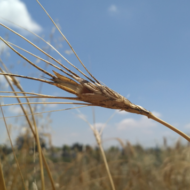
In a time of academic boycotts of Israel, an Israeli-led global team breaks wheat’s genetic code, a major advance in the fight against global hunger.
A global team of researchers, led by Dr. Assaf Distelfeld of Tel Aviv University (TAU), have published the first-ever wild emmer wheat genome sequence, which could be used to improve the performance of modern day grains.
Wild emmer wheat is the original form of nearly all domesticated wheat in the world, including durum (pasta) and bread wheat.
Wild emmer is too low-yielding to be of use to farmers today, but it contains many attractive characteristics that are being used by plant breeders to improve wheat.
“This research is a synergistic partnership among public and private entities,” said Dr. Daniel Chamovitz, Dean of TAU’s George S. Wise Faculty of Life Sciences, who was also involved in the research. The research was conducted in collaboration with several dozen scientists from institutions around the world and an Israel-based company, NRGene, which developed the bioinformatics technology that accelerated the research.
“Ultimately, this research will have a significant impact on global food security,” Chamovitz said.
“Our ability to generate the wild emmer wheat genome sequence so rapidly is a huge step forward in genomic research,” said Dr. Curtis Pozniak from the University of Saskatchewan, a project team member and Chair of the Canadian Ministry of Agriculture Strategic Research Program.
“Wheat accounts for almost 20 percent of the calories humans consume worldwide, so a strong focus on improving the yield and quality of wheat is essential for our future food supply,” Pozniak explained.
A Biological ‘Time Tunnel’
“From a biological and historical viewpoint, we have created a ‘time tunnel’ we can use to examine wheat from before the origins of agriculture,” said Distelfeld. “Our comparison to modern wheat has enabled us to identify the precise genes that allowed domestication – the transition from wheat grown in the wild to modern day varieties. While the seeds of wild wheat readily fall off the plant and scatter, a change in two genes meant that in domesticated wheat, the seeds remained attached to the stalk; it is this trait that enabled humans to harvest wheat.”
“This new resource allowed us to identify a number of other genes controlling main traits that were selected by early humans during wheat domestication and that served as foundation for developing modern wheat cultivars,” said Dr. Eduard Akhunov of Kansas State University. “These genes provide invaluable resources for empowering future breeding efforts. Wild emmer is known as a source of novel variation that can help to improve the nutritional quality of grain as well as tolerance to diseases and water-limiting conditions.”
Drought-Resistant Wheat
“New genomic tools are already being implemented to identify novel genes for wheat production improvement under changing environment,” explains Dr. Zvi Peleg of the Hebrew University of Jerusalem, Israel. “While many modern wheat cultivars are susceptible to water stress, wild emmer has undergone a long evolutionary history under the drought-prone Mediterranean climate. Thus, utilization of the wild genes in wheat a breeding program promotes producing more yield for less water.”
“The wheat genome is much more complex than most of the other crops and has a genome three times the size of a human genome.” said Dr. Gil Ronen, NRGene’s CEO. “Still, the computational technology we developed has allowed us to quickly assemble the very large and complex genome found in wild emmer’s 14 chromosomes, to a standard never achieved before in genomic studies.”
Game-Changing Technologies
For the first time, the sequences of the 14 chromosomes of wild emmer wheat are collapsed into a refined order, thanks to additional technology that utilizes DNA and protein links. “It was originally tested in humans and recently demonstrated in barley, both of which have smaller genomes [to] wild emmer wheat.” says Dr. Nils Stein, the Head of Genomics of Genetic Resources at Leibniz Institute of Plant Genetics and Crop Plant Research in Germany. “These innovative technologies have changed the game in assembling the large cereal genomes.”
“This sequencing approach used for wild emmer wheat is unprecedented and has paved the way to sequence durum wheat (the domesticated form of wild emmer). Now we can better understand how humanity transformed this wild plant into a modern, high-yielding durum wheat,” said Dr. Luigi Cattivelli, co-author of the work and coordinator of the International Durum Wheat Genome Sequencing Consortium.
“We now have the tools to study crops directly and to make and apply our discoveries more efficiently than ever before,” concluded Dr. Distelfeld.
By: Max Gelber, United with Israel
Do You Love Israel? Show Your Support!
Donate to vital charities that protect Israelis and help educate and inspire millions around the world to support Israel too!
Now more than ever, Israel needs your help to fight the battle of public opinion. Israel’s enemies are using social media to incite brutal terror against innocent civilians. Please help us fight back!
Source: United with Israel
